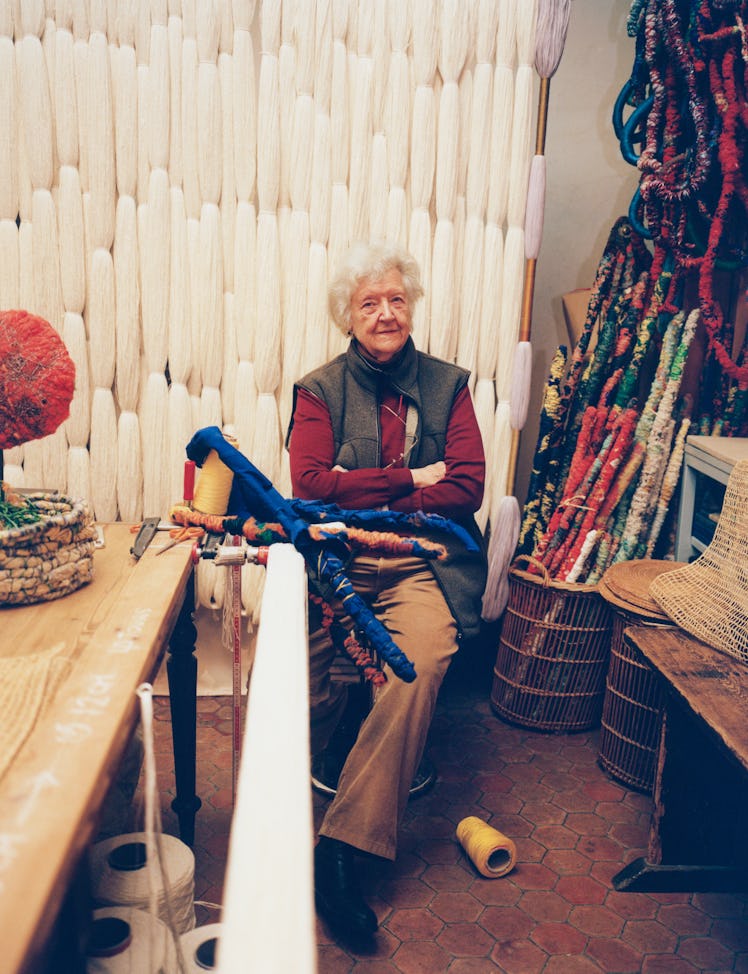Sheila Hicks Just Keeps Spinning
The legendary textile artist on the creative process that keeps her going.

At 87, you are a longtime Paris resident and an unstoppable maker who basically invented her own category of fiber art. Now you have a big solo exhibition, “Sheila Hicks: Off Grid,” at the Hepworth Wakefield museum, in England, beginning April 7. What’s special about this show?
The thing I’m most excited about is that the building is by the architect David Chipperfield. They gave me a model of the galleries, with these irregular, unpredictably shaped spaces and light sources—it’s like having a dollhouse. There are strange surprises, and a very wide span. We’ve dug up some pieces and reformulated them. There are some rooms that provide an opportunity I’ve never had before, like a hanging space with a clerestory.
Many of your colorful fiber works hang, but sometimes they lie flat, squat, or linger oddly—they have an interesting relationship to gravity.
Gravity is a big player in my work. We have cascades, spills, crashes...the pieces tremble on the floor. They imply that if you come back tomorrow, they may have moved and morphed overnight. When you work with pliable and supple materials, you’re supposed to follow what the material expects and wants, but I defy that in a playful way.
Is that what makes you so original?
I’m fun-loving. I’m rebellious against tristesse and devastation. I’m not a very decisive person, but I’m alert, and I get tempted and lured into things. That’s how I got to France: This teacher at Yale invited me to lunch and said, “I heard about you. I want to arrange a grant. You’ll never be a truly cultivated woman until you know La France.” I thought I’d give it a chance. Then, once in it, you swim. I’ve been here since 1964.
Saffron Sentinel, 2017.
Famously, you studied painting at Yale with Homage to the Square maestro Josef Albers, and also got to know his wife, Anni Albers, a still underappreciated textile genius.
Albers saw me struggling with these primitive thread exercises and said he was taking me home to meet his wife. I got there, and Anni was a little bit off-putting in her reserve. She said, “Come back next week and take pictures of my work.” I shot her work for her, and it helped me to look at things structurally.
What are your work habits?
Sometimes, if I’m on deadline, I don’t even go to bed. I live and work in the same courtyard, so I don’t have to take the Métro. It has cobblestones, my courtyard; you can see it in the rain and the moonlight. The cobblestones have a lot to do with my work. It’s a repetitive, textured surface. They’re units. And I like the way the units repeat and change, like handwriting.
Is it difficult to work this hard in your late 80s?
I haven’t noticed. I’m tired most of the time, but I’m happy, and when I am working, I forget about being tired. Some of my friends are as old as I am, and they are working hard too. Do you know the writer Monique Lévi-Strauss? She’s one of my best friends here, and she’s 96. We go to a lecture or show once a week. I have a hard time keeping up with her.
It sounds like you know how to balance work and play—or, rather, work is play?
I’m always pushing all my chores aside so I can go and play. But I’m very disciplined in the sense of being hard on myself. I would say I’m extremely severe about the aesthetic challenges I have to meet. And if I don’t meet them, I don’t destroy the work, but I route things around until they have a presence that I can bear and admire.
So you’re saying you don’t throw the offending piece out, but rather take it and transform it?
I recycle the same works. That’s what’s great about thread and yarn. I don’t want something ugly hanging around. So I keep pushing it, pulling it, turning it upside down and backwards. Stepping on it, dropping it from the second story of the courtyard.
Cordes Sauvages/Hidden Blue, 2014.
It all comes back to the courtyard.
Right in front of me is the Giacometti Foundation, and every time I come home and go upstairs to my apartment, I look to see if the lights are still on and they’re still working. That encourages me. They’re perpetuating his legacy and dealing with the forgeries, authenticating things. Not forgeries—I should say emulations.
I think you’re good enough to inspire copycats.
Someone invited me to do an exhibition in China, and a friend said, “Don’t go there. Everyone will be emulating what you’re doing, copying it.” I look at that and think, That’s great. Why should I be afraid of that? The dealers might be upset, but I’m not.
© Sheila Hicks, courtesy of Alison Jacques Gallery, London (2).
This article was originally published on